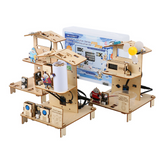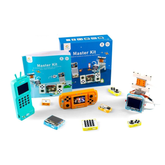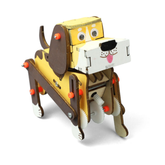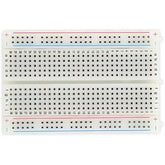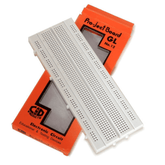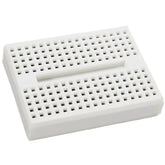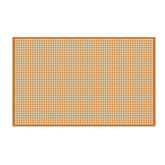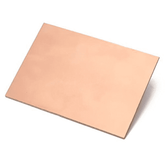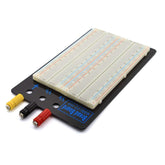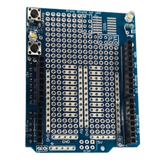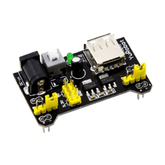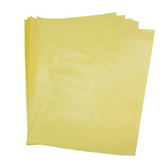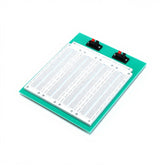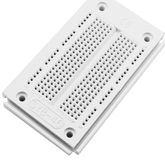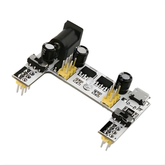-
400 Tie Points Solderless Breadboard400 Tie Points Solderless Breadboard The 400 Tie Point solderless breadboard is perfect for building and testing electronics, especially with Arduino projects. It’s made of strong plastic with metal clips that hold wires securely. With 400 points, you can quickly set up circuits without...
- Rs. 32
Rs. 59- Rs. 32
- Unit price
- per
Save Rs. 27 -
GL12 840 Points Solderless BreadboardGL12 MB102 840 Points Solderless Breadboard Introducing the GL12 840 Points Breadboard at Robocraze! This solderless breadboard is an essential tool for any electronics engineer or hobbyist. It allows you to make temporary prototypes for your electronics projects, making it perfect for experimenting with...
- Rs. 53
Rs. 89- Rs. 53
- Unit price
- per
Save Rs. 36 -
170 Points Mini Breadboard170 Points Mini Breadboard This 170 Points Mini Breadboard is the ideal companion for seamless electronics prototyping, designed to provide a hassle-free experience. With a 2x17 row layout and a total of 170 pins, this prototyping breadboard offers abundant space to create and test...
- Rs. 17
Rs. 29- Rs. 17
- Unit price
- per
Save Rs. 12 -
Vero board (3x4 Inch)Vero board (3x4 Inch) Veroboard is a brand of stripboard, a pre-formed circuit board material of copper strips on an insulating bonded paper board which was originated and developed in the early 1960s. VeroBoard is a new type of surface mount technology(SMT) and integrated...
- Rs. 24
Rs. 30- Rs. 24
- Unit price
- per
Save Rs. 6 -
VeroBoard(6x4 Inch)VeroBoard(6x4 Inch) Vero board can be used to build prototypes for bench testing, design early electronic circuits, or produce entire electronic equipment in small quantities. The Vero Electronics Department used Veroboard for prototype building for the first time in 1961. By soldering components to...
- Rs. 39
Rs. 52- Rs. 39
- Unit price
- per
Save Rs. 13 -
15cm x 10cm Single Side Copper Clad Laminate PCB Board15cm x 10cm Single Side Copper Clad Laminate PCB Board Ideal for building a prototype of electronic circuit, double sided copper PCB. Mechanically assisted and electrically connects electronic components with conductive rails, pads and other features etched from copper plates on a non-conductive substrate....
- Rs. 38
Rs. 45- Rs. 38
- Unit price
- per
Save Rs. 7 -
1660 tie-point Solderless Breadboard1660 tie-point Solderless Breadboard The 1660 Points Solderless Breadboard is an excellent size with more than enough room for more advanced prototyping. There are two terminal strips with 1260 tie-points and 4 distribution strips with 400 tie-points. The breadboards accept a variety of wire sizes from 20 to...
- Rs. 464
Rs. 699- Rs. 464
- Unit price
- per
Save Rs. 235 -
Arduino UNO Prototyping ShieldUNO Prototyping Shield for Arduino UNO Prototype Shield is used in the cases where you want to build more applications without using any external Breadboard. This prototyping shield for Arduino helps in expanding the functionalities of UNO board and create extra connections for embedded...
- Rs. 77
Rs. 114- Rs. 77
- Unit price
- per
Save Rs. 37 -
Breadboard Power Supply (3.3V-5V)Breadboard Power Supply (3.3V/5V) This is a 3.3V/5V MB102 Breadboard Power Supply Module which provides a dual 5 V and 3.3 V power rails and has a multi-purpose female USB socket. The 3.3V/5V MB102 Breadboard Power Supply Module securely fits in a standard 400 tie point breadboard...
- Rs. 59
Rs. 79- Rs. 59
- Unit price
- per
Save Rs. 20 -
Bread Board + Power SupplyBread Board + Power Supply This is a 3.3V/5V MB102 Breadboard Power Supply Module which provides a dual 5 V and 3.3 V power rails and has a multi-purpose female USB socket. The breadboard is the most essential tool for an electronics engineer. It makes prototyping...
- Rs. 199
Rs. 249- Rs. 199
- Unit price
- per
Save Rs. 50 -
Half Bread Board + Power SupplyHalf Breadboard + Power Supply This is a 3.3V/5V MB102 Breadboard Power Supply Module which provides a dual 5 V and 3.3 V power rails and has a multi-purpose female USB socket. The breadboard is the most essential tool for an electronics engineer. It makes prototyping a...
- Rs. 139
Rs. 199- Rs. 139
- Unit price
- per
Save Rs. 60 -
High Quality PCB Toner Transfer Paper A4 Size for DIY Electronics (Pack of 5)PCB Toner Transfer Paper A4 Size for DIY Electronics This PCB Toner Transfer Paper A4 Size is specially designed for DIY electronics enthusiasts looking to fabricate custom PCBs at home. Using this high-quality toner transfer paper, you can easily transfer your PCB artwork onto...
- Rs. 79
Rs. 99- Rs. 79
- Unit price
- per
Save Rs. 20 -
High Quality PCB Toner Transfer Paper A4 Size for DIY Electronics (Pack of 10)PCB Toner Transfer Paper A4 Size for DIY Electronics This PCB Toner Transfer Paper A4 Size is specially designed for DIY electronics enthusiasts looking to fabricate custom PCBs at home. Using this high-quality toner transfer paper, you can easily transfer your PCB artwork onto...
- Rs. 188
Rs. 249- Rs. 188
- Unit price
- per
Save Rs. 61 -
SYB-500 Large Solderless Breadboard – 3220 Tie-Point Prototyping Board (240×200×8.5mm)SYB-500 Large Solderless Breadboard – 3220 Tie-Point Prototyping Board (240×200×8.5mm) The SYB-500 Large Breadboard is a high-capacity solderless prototyping board designed for advanced electronics development, circuit testing, and educational experimentation. With its spacious layout and durable construction, this board provides an efficient platform for...
- Rs. 649
Rs. 744- Rs. 649
- Unit price
- per
Save Rs. 95 -
SYB-46 270 Points Solderless Breadboard for Prototyping & Arduino & ElectronicsSYB-46 270 Points Solderless Breadboard for Prototyping & Arduino & Electronics The SYB-46 270 Points Breadboard is a compact and reliable solderless prototyping platform designed for small electronics projects, testing circuits, and learning the basics of electronics. With 270 tie points and a space-saving...
- Rs. 46
Rs. 59- Rs. 46
- Unit price
- per
Save Rs. 13 -
Breadboard Power Supply Module – Micro USB & DC 7–12V Dual ChannelBreadboard Power Supply Module – Micro USB & DC 7–12V Dual Channel The MB102 Breadboard Power Supply Module is a reliable and efficient tool designed for powering electronic circuits during prototyping and testing. It features dual power channels and supports both Micro USB and...
- Rs. 99
Rs. 149- Rs. 99
- Unit price
- per
Save Rs. 50
for additional 5% discount! + Redeem RC COINS 👇



